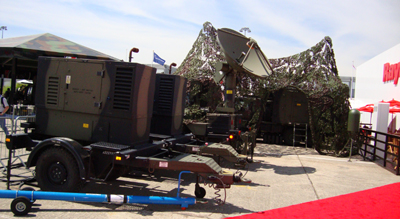|
According to Admiral Walter F Doran, President
Asia for Raytheon, Indian officials had alredy
been briefed on “this latest radar, for highly
effective 24-hour surveillance and target acquisition
capability.” The system is being operated
now by the British Army and Royal Air Force (RAF)
in Afghanisatan with five ASTOR aircraft and eight
ground stations.
 Admiral
Doran told India Strategic during
a visit here recently that Raytheon, a military
technology giant, had also submitted a formal
proposal to the Indian government. He declined
to give details. Admiral
Doran told India Strategic during
a visit here recently that Raytheon, a military
technology giant, had also submitted a formal
proposal to the Indian government. He declined
to give details.
First deployed in 2008, ASTOR can even detect
minor variations in surface levels, like digging
and filling of earth at the same place, and draw
conclusions about activity. The system consists
of an Active Electronically Scanned Array (AESA)
radar on board the Bombardier Global Express ‘Sentinel’
business jet. Indian officials first visited the
aircraft displayed at the Paris Air Show in June
2009 and have followed up with discussions.
Admiral Doran, a former US Navy’s 7th Fleet
Commander, said that “the capability on board
the ASTOR was unmatched,” pointing out that
although Raytheon did not make platforms, its
combat systems were on board most of the US aircraft,
ships, spacecraft and land vehicles. For instance,
the AESA radar on board the Boeing F 18 Super
Hornet, F 15 Eagle and P8 Multi-mission Maritime
Aircraft (for the US and Indian Navies) is built
by Raytheon.
The company has also built an AESA radar for
F 16s, should a country buying it make the choice
in its favour.
So was the Mini-SAR, or the Miniaturized Synthetic
Aperture Radar, on board India’s lunar mission
Chandrayaan-1 which located ice on the polar surface
of moon through high resolution imagery.
Raytheon provided the Mini-SAR to NASA, which
gave it to the Indian Space Research Organisation
(ISRO) for its lunar mission as part of their
cooperative venture. NASA later sent another mission
with a higher resolution SAR camera.
 Admiral
Doran said that ASTOR flies high enough –
40,000 to 45,000 feet – to cover a large
ground area, and to be beyond the range of most
Surface to Air Missiles (SAMs). It is also equipped
with a self protection suite to put out flares
and chaff to confuse and deflect any threatening
missiles. Admiral
Doran said that ASTOR flies high enough –
40,000 to 45,000 feet – to cover a large
ground area, and to be beyond the range of most
Surface to Air Missiles (SAMs). It is also equipped
with a self protection suite to put out flares
and chaff to confuse and deflect any threatening
missiles.
ASTOR’s main equipment includes a dual-mode
SAR and Moving Target Indicator (SAR/MTI), part
of the AESA system. The aircraft can fly for nine
hours at a stretch.
There are three consoles for monitoring the ground,
two for image analysts and one for the Airborne
Mission Commander, besides the pilot and co-pilot.
Data from the aircraft is fed to the ground stations
from where action against hostile targets is initiated
if required.
|